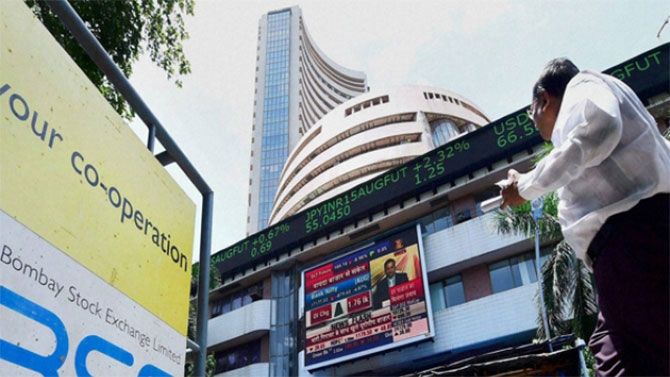 | « Back to article | Print this article |
If the rupee falls further, it would negatively impact the dollar-based returns of foreign investors, and could influence foreign flows into India.
Sachin P Mampatta reports

Foreign investors who put their money into India's stock market and held onto their portfolios through the financial ups and downs of the last decade have made virtually no gains, thanks to a falling rupee.
The market, however, touched new highs in this period.
The returns for foreign investors are adjusted for currency.
A falling rupee erodes the gains of such investors. The rupee was under 40 against the dollar in January 2008. It closed at 68.53 on July 13, a depreciation of about 70 per cent in 10 years.
Since the start of 2018, the rupee is down about 7 per cent against the greenback.
The exact Sensex returns for such investors can be tracked through the S&P BSE Dollex 30.
This index adjusts Sensex movements for currency fluctuations against the dollar.
It had hit its pre-crises peak of 4,365 on January 8, 2008, and closed at 4,379.81 on July 13, representing a gain of 14.81 points, or 0.34 per cent, in 10 years.
In comparison, the Sensex is up 75 per cent.
The S&P BSE Sensex, a 30-stock index whose returns are held to be broadly representative of the market, moved past 36,000 this week and hit an all-time high.
Gautam Chhaochharia, India head of research at UBS Group AG, said currency was, and remains, a factor for foreign flows.
"For global investors, it matters, obviously. But currency is not an absolute... it is also related to other currencies. So, 2012-2013 was unique because India was (part of the) fragile five. The Indian rupee depreciated a lot more than the broader emerging markets. Then it hurt India, but right now that's not the case. But in general, it matters because a lot of the money is dollar-return-based," he said.
A Morgan Stanley India Company report pointed to India doing better than its emerging market peers on the back of macroeconomic stability, though returns would be limited by poor global conditions.
'India's falling relative short rates, likely rising relative growth rates and a fall in FPI (foreign portfolio investor) positioning to 2011 levels add to the outperformance case,' said the India Equity Strategy Alpha Almanac report, authored by equity strategists Ridham Desai and Sheela Rathi and published on June 18.
Foreign portfolio investors who were already overweight on India had been allocating money to other emerging markets as fundamentals took time to meet expectations.
Since these portfolio adjustments are mostly done, India could see inflows now if there are fresh allocations to emerging markets, according to Chhaochharia.
FPIs have largely been net sellers this calendar year, though there have also been periods of buying.
Gautam Duggad, head of research, Motilal Oswal Securities, believes that flows were expected to remain volatile despite an improvement in fundamentals.
"Earnings are expected to recover," he said. But flows may move in response to other factors such as politics and global trade wars.
The US, China and other European countries have been announcing trade barriers in recent weeks. India is set to see a number of state elections before the all-important general election/
Meanwhile, forecasts by Macquarie Bank, DBS Group Holdings and others have pegged the rupee to fall to 71 and beyond over the next year.
If the rupee does see further pressure, it would negatively impact the dollar-based returns of foreign investors, and could also influence foreign flows into India.
Photograph: PTI